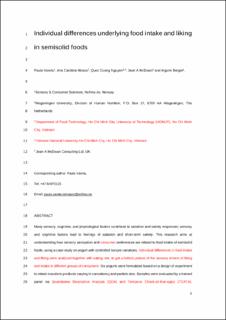| dc.description.abstract | Many sensory, cognitive, and physiological factors contribute to satiation and satiety responses; sensory and cognitive factors lead to feelings of satiation and short-term satiety. This research aims at understanding how sensory perception and consumer preferences are related to food intake of semisolid foods, using a case study on yogurt with controlled texture variations. Individual differences in food intake and liking were analyzed together with eating rate, to get a holistic picture of the sensory drivers of liking and intake in different groups of consumers. Six yogurts were formulated based on a design of experiment to obtain isocaloric products varying in consistency and particle size. Samples were evaluated by a trained panel via Quantitative Descriptive Analysis (QDA) and Temporal Check-all-that-apply (TCATA). Additionally, 103 consumers ate ad libitum the yogurt samples and rated their liking. Amount eaten was measured by weight and eating rate via video recording. The effect of particle size on intake depended on the thickness of the matrix. Based on Principal Component Analysis (PCA), three groups of consumers were identified that reacted differently to the changes in yogurt texture in terms of amount eaten and liking responses. While for some consumers liking and intake were correlated, others ate more of what they liked less, driven by textural changes in the matrix. Results suggested that different patterns in intake and liking may be related to different eating styles, thus, manipulations on textural properties may reduce the intake for some consumers, but not for all. This work unveils the importance of studying individual differences when measuring food intake, together with static and dynamic sensory drivers for different segments of consumers. In a time where food personalization increases in focus, it seems possible to reformulate food texture to influence consumers expectations and intake, aiming at targeting overeating; however, individual differences need to be better understood to know the implications for different groups of consumers. | |
